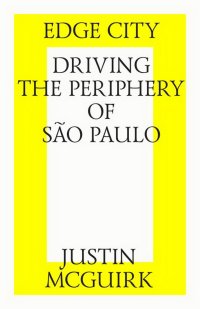Edge city: Driving the periphery of São Paulo = Город на грани. Поездка по окраинам Сан-Паулу
Покупка
Тематика:
Градостроительство
Издательство:
Стрелка Пресс
Автор:
Макгирк Джастин
Год издания: 2017
Кол-во страниц: 59
Дополнительно
Вид издания:
Научно-популярная литература
Уровень образования:
Профессиональное образование
ISBN: 978-5-9903364-2-1
Артикул: 688053.01.99
Exploring the edge condition of São Paulo, Justin McGuirk analyses the
different forms of dwelling available to its would-be citizens, and meets some of
the people carving a life for themselves on the verge of this unforgiving metropolis.
Driving anti-clockwise, we take a journey backwards in time, moving from
cardboard favelas and hastily built tower blocks back to modernist social housing
and the factory town built early in the last century. Is this a tale, as the Brazilian
flag attests, of «order and progress»? Are the citizens of the periphery better off
looking after themselves than in the hands of developers and the paternalistic state?
Part road trip and part urban critique, this drive-by portrait makes the case that the
city is best understood not by its centre but by its edge.
Тематика:
ББК:
УДК:
ОКСО:
- 07.00.00: АРХИТЕКТУРА
- ВО - Бакалавриат
- 07.03.01: Архитектура
- 07.03.03: Дизайн архитектурной среды
- ВО - Магистратура
- 07.04.01: Архитектура
- 07.04.03: Дизайн архитектурной среды
ГРНТИ:
Скопировать запись
Фрагмент текстового слоя документа размещен для индексирующих роботов
МАКГИРК ДЖАСТИН ГОРОД НА ГРАНИ. ПОЕЗДКА ПО ОКРАИНАМ САН-ПАУЛУ 3-е издание (электронное) Москва «Стрелка Пресс» 2017
MCGUIRK JUSTIN EDGE CITY: DRIVING THE PERIPHERY OF SAO PAULO 3-rd edition (electronic) Moscow Strelka Press 2017
УДК 72
ББК 85
M12
McGuirk, Justin.
M12 Edge city: Driving the periphery of Sao Paulo = Город на грани. Поездка по окраинам Сан-Паулу [Электронный ресурс] / J. McGuirk. — 3-rd ed. (el.). — Electronic text data (1 file pdf : 59 p.). — М. : Strelka Press, 2017. — System requirements: Adobe Reader XI or Adobe Digital Editions 4.5 ; screen 10".
ISBN 978-5-9903364-2-1
Exploring the edge condition of Sao Paulo, Justin McGuirk analyses the different forms of dwelling available to its would-be citizens, and meets some of the people carving a life for themselves on the verge of this unforgiving metropolis. Driving anti-clockwise, we take a journey backwards in time, moving from cardboard favelas and hastily built tower blocks back to modernist social housing and the factory town built early in the last century. Is this a tale, as the Brazilian flag attests, of «order and progress»? Are the citizens of the periphery better off looking after themselves than in the hands of developers and the paternalistic state? Part road trip and part urban critique, this drive-by portrait makes the case that the city is best understood not by its centre but by its edge.
УДК 72
ББК 85
The source print publication: Edge city: Driving the periphery of Sao Paulo / J. McGuirk. — Moscow : Strelka Press, 2014. — 57 p. — ISBN 978-0-9929-1467-7.
ISBN 978-5-9903364-2-1
© Strelka Institute for Media, Architecture and Design, 2014
Municipal housing on the outskirts of Sao Paulo — 5 —
Sao Paulo, the largest city in South America, is an arsenal of statistics for the shock-and-awe urbanist. You might read that Sao Paulo is a megacity of 19 million people, and that it has grown 8,000 per cent since 1900. Does that help us understand the city? Does it reveal some essential characteristic? In a limited sense, yes, but it also reinforces what we already know. Speed has always been this city’s raison d’etre. In Tristes Tropiques, Claude Levi-Strauss wrote of his time there in 1935: “The town is developing so fast that it is impossible to obtain a map of it.” In the middle of the 20th century, when the city was the engine of the “Brazilian Miracle”, a popular slogan proclaimed “Sao Paulo must not stop” — it was “the unstoppable city”.
Today, despite the staggering statistics, Sao Paulo is slowing down. The population is not growing anywhere near as fast as it used to, but all of that growth is happening in one zone: the periphery. Sao Paulo’s sprawling fringes reveal a city that is still very much in the making, still somehow raw. It is a place where the sacrifices that people make for access to the city are written into the landscape, into the fabric of their homes. Cities that grow this fast grow in an unconsolidated way, and so while the periphery is full of pathos it is also full of potential.
This is the record of a drive around the periphery of Sao Paulo. In London Orbital, Iain Sinclair spent months walking the M25, the city’s ring road, in an attempt to understand and embrace the sprawl. I have no such inclinations, and not just because the distances involved are even more perverse. Sao Paulo is not a city for walking, it’s a city of cars — six million of them. In that spirit, this is emphatically a drive, and as such it is an unapologetically blurred snapshot of a city
— 6 —


